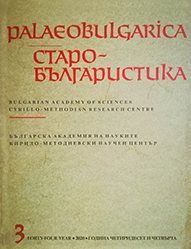Тайнописание и инописание (Новации русской письменности в пору Второго южнославянского влияния)
Cryptography and Alternative Writing Systems (Inopisanie) (Innovations of Russian Literature at the Time of the Second South Slavic Influence)
Author(s): Dmitriy M. BulaninSubject(s): Language studies, Language and Literature Studies
Published by: Кирило-Методиевски научен център при Българска академия на науките
Keywords: cryptography; Second South Slavic influence; Bulgarian orthography; dualism; magical purification; mysticism; sacrilege; functions; teratology; margin notes
Summary/Abstract: The article aims to trace the Second South Slavic influence on Russian literature with the help of rather specific material that one can find in Old Russian manuscripts of the 14-15th centuries. The material the author focuses his attention on consists of cryptographic writings and cryptographic insertions in manuscript books, phenomena of book culture that according to the original theory developed in the article, represent one particular section of monuments using alternative writing systems (inopisanie) (the neologism proposed in this paper). Under the monuments using alternative writing systems (inopisanie) the author understands any and all specific text elements of manuscript codices that stand out by some signals against the general background of the text. Signals of this kind were used to inform the recipient that the scribe (or anybody else armed with a pen) was about to change over to a new register of writing. The author insists that the change of register in the books of religious content (other kinds of books did not exist at that time) necessarily had a religious motivation. Moreover, as demonstrated in the article, the border separating the period of the Second South Slavic influence from the previous one is quite tangible in the history of ancient Russian cryptography and alternative writing systems (inopisanie). Phenomena of “inopisanie” started to be by far more widespread, and the assortment of the “inopisanie” was enriched by new encrypting systems and with new ways of highlighting the texts. This tendency reflects a general striving for a noumenal world and a universal thirst for a mystical union with the Divine that are typical for this time. On the other hand, the onset of a new period in the history of culture was marked for Russian literature by the loss of the attributes that had been typical for it in previous years. Among those attributes that were lost one should pay attention to the dichotomous perception of the manuscript page onto which the dualistic picture of the world was projected (the degeneration of the teratological style, the disappearance of naturalistic and even sacrilegious margin notes in the manuscripts).
Journal: PALAEOBULGARICA / СТАРОБЪЛГАРИСТИКА
- Issue Year: 2020
- Issue No: 3
- Page Range: 58-80
- Page Count: 23
- Language: Russian
- Content File-PDF

